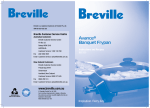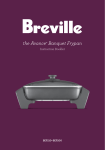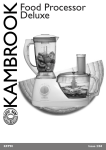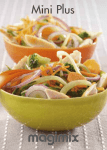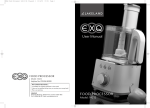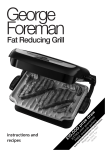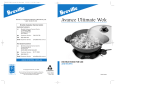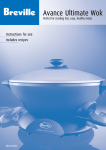Download Get the Instruction Book for this product
Transcript
the Banquet Pan™ Breville Customer Service Centre Australian Customers Mail: PO Box 22 Botany NSW 2019 AUSTRALIA Phone: 1300 139 798 Fax: (02) 9384 9601 Email: Customer Service: [email protected] Instruction Booklet New Zealand Customers Mail: Private Bag 94411 Botany Manukau 2163 Auckland NEW ZEALAND Phone: 0800 273 845 Fax: 0800 288 513 Email: Customer Service: [email protected] www.breville.com.au Breville is a registered trademark of Breville Pty. Ltd. A.B.N. 98 000 092 928. Copyright Breville Pty. Ltd. 2013. Due to continued product improvement, the products illustrated/photographed in this booklet may vary slightly from the actual product. BEF200/BEF200S Issue - A13 BEF200/BEF200S CONTENTS BREVILLE RECOMMENDS SAFETY FIRST 3 Breville recommends safety first 5 Know your Breville product 6 Operating your Breville product 7 Care & cleaning 9 Cooking techniques 12Recipes At Breville we are very safety conscious. We design and manufacture consumer products with the safety of you, our valued customer, foremost in mind. In addition we ask that you exercise a degree of care when using any electrical appliance and adhere to the following precautions. IMPORTANT SAFEGUARDS READ ALL INSTRUCTIONS BEFORE USE AND SAVE FOR FUTURE REFERENCE • Remove and safely discard any packaging material and promotional labels before use. • To eliminate a choking hazard for young children, remove and safely discard the protective cover fitted to the power plug of this appliance. • Always ensure the appliance is properly assembled before use. Follow the instructions provided in this book. • Do not touch hot surfaces. Appliance surfaces are hot during and after operation. To prevent burns or personal injury, always use protective hot pads or insulated oven mitts, or use handles or knobs where available. • Do not place the appliance near the edge of a bench or table during operation. Ensure that the surface is dry, level, clean and free of any liquid and other substances. • Always operate the appliance on a stable and heat resistant surface. Do not use on a cloth-covered surface, and position the appliance at a minimum distance of 20cm away from walls, curtains, cloths and other heat sensitive materials. • Do not place this appliance on or near a hot gas or electric burner, or where it could touch a heated oven. • Do not operate the appliance on a sink drain board. • When operating the appliance, ensure the power cord is kept away from any heat source including the surface of the appliance. • Do not touch hot surfaces. Use the handles for lifting and carrying the frypan. 2 • Always fully insert temperature control probe into probe socket before inserting power plug into the power outlet and switching on. Ensure the probe socket is completely dry before inserting the temperature control probe. • The frypan must be used with the temperature probe provided. Do not use any other temperature probe or connector. • Ensure the temperature control probe has cooled before removing it from the appliance. • Always remove the temperature control probe before cleaning the appliance. • If using plastic utensils, do not leave in the frypan when hot. • Do not place hot glass lid under cold water. • Do not place anything on top of the appliance lid when the lid is closed, when in use and when stored. • Extreme caution must be used when the appliance contains hot oil or other liquid. Do not move the appliance during cooking. Allow the frypan to cool before removing oil or other liquid. • Do not use harsh abrasives, caustic cleaners or oven cleaners when cleaning this appliance. Keep the appliance clean and refer to care and cleaning section. • Do not attempt to operate the appliance by any method other than those described in this booklet. Do not leave the appliance unattended when in use. • Always have the glass lid positioned correctly on the frypan throughout operation of the appliance unless stated in the recipe to have it removed. 3 BREVILLE RECOMMENDS SAFETY FIRST • The glass lid has been specially treated to make it stronger, more durable and safer than ordinary glass, however it is not unbreakable. If struck extremely hard, it may break or weaken and could at a later time shatter into many small pieces without apparent cause. • To protect against electric shock, do not immerse the temperature control probe, power cord, power plug or appliance in water or any other liquid. • Always turn the probe to the MIN position, switch off at the power outlet, remove the plug and allow all parts to cool before attempting to move the appliance, when the appliance is not in use, before cleaning and when storing. IMPORTANT SAFEGUARDS FOR ALL ELECTRICAL APPLIANCES • Unwind the power cord fully before use. • Do not let the power cord hang over the edge of a bench or table, touch hot surfaces or become knotted. • Connect only to a 230V or 240V power outlet. • The appliance is not intended for use by persons (including children) with reduced physical, sensory or mental capabilities, or lack of experience and knowledge, unless they have been given supervision or instruction concerning use of the appliance, by a person responsible for their safety. KNOW YOUR BREVILLE PRODUCT • Children should be supervised to ensure that they do not play with the appliance. • It is recommended to regularly inspect the appliance. Do not use the appliance if the power cord, power plug or appliance becomes damaged in any way. Return the entire appliance to the nearest authorised Breville Service Centre for examination and/or repair. • Any maintenance, other than cleaning, should be performed at an authorised Breville Service Centre. • This appliance is for household use only. Do not use this appliance for other than its intended use. Do not use in moving vehicles or boats. Do not use outdoors. Misuse may cause injury. • The appliance is not intended to be operated by means of an external timer or separate remote control system. • The installation of a residual current device (safety switch) is recommended to provide additional safety protection when using electrical appliances. It is advisable that a safety switch with a rated residual operating current not exceeding 30mA be installed in the electrical circuit supplying the appliance. See your electrician for professional advice. A B C D G F E H WARNING Do not operate the frypan on an inclined surface. Do not move the frypan while it is switched on. I A. Dishwasher safe glass lid With adjustable steam vent. B. Large rectangular 38cm x 29.5cm frypan C. Extra deep 78mm pan D. Cool touch handles E. High quality non-stick cooking surface F. Powerful 2200 watt die-cast element G. Non-slip feet H. Trigger release removable variable temperature control probe With 10 heat settings. I. Pan tilt lever SAVE THESE INSTRUCTIONS 4 5 OPERATING YOUR BREVILLE PRODUCT BEFORE FIRST USE Remove and safely discard any packaging material or promotional stickers before using your frypan for the first time. It is recommended before the first use to wash your frypan and lid in hot soapy water. Rinse and dry thoroughly. Do not immerse the power cord, power plug and/or temperature control probe in water or any other liquid. CARE & CLEANING 4. When cooking is completed, turn the dial anti-clock-wise until it is aligned with the MIN. Switch off at the power outlet and unplug power cord. 5. Leave the temperature control probe connected to the appliance until cool. 6. Remove the temperature control probe and follow the cleaning instructions to clean the frypan (page 7). OPERATION OF YOUR FRYPAN NOTE 1. Insert the temperature control probe into the probe socket on the appliance. Plug power cord into a 230/240V power outlet and switch ON. Always insert the probe into the appliance first, then insert power plug into power outlet. To adjust the steam outflow from the frypan, turn the adjustable steam vent attached to the knob on the glass lid. NOTE Before inserting the temperature control probe into the probe socket; ensure the interior of the socket is completely dry. To do this, shake out excess water then wipe the interior of the socket with a dry cloth. This frypan must be used with the temperature control probe provided. Do not use any other probe or connector. 2. Turn the dial on the temperature control probe clockwise to the desired setting. The red heating light on the probe will illuminate. 3. The red heating light will remain illuminated until the frypan reaches the desired temperature. Once the temperature has been reached, the red light will cycle ON and OFF during cooking to maintain the desired temperature. 6 USING THE PAN TILT LEVER Pan tilt lever is located under the temperature control probe. Pull lever away from base and rest in upright position on bench top. This will slope frypan to one side so that when sautéing or roasting, oil/fats can collect in one area away from food. CARE • Do not leave plastic cooking utensils in contact with the hot frypan surface while cooking. • Do not use metal utensils on the non-stick coating of the frypan. Only use wooden or good quality plastic utensils to stir or serve food. • Before cleaning, switch the frypan to MIN and unplug power cord from the power outlet. Remove the temperature control probe when cooled, from the probe socket of the appliance. CLEANING Temperature control probe • If cleaning is necessary, wipe the temperature control probe over with a slightly damp cloth. Ensure it is completely dry before use. NOTE Never immerse the temperature control probe, power plug or power cord in water or any other liquid. Removing discolouration of the non-stick surface • Combine 2 tablespoons bicarbonate of soda, ¼ cup household bleach, 1 cup water. • Pour into the frypan, place lid on with the vent closed, and simmer for 5–10 minutes. • Clean in a well-ventilated area and avoid breathing in the vapours. Wash as directed before re-use. In some instances this may not remove all the staining. Glass lid Wash the lid in warm soapy water using a soft cloth or sponge, rinse and dry thoroughly. Dishwasher safe Your frypan and glass lid are dishwasher safe for easy cleaning. Remove the probe and power cord before placing frypan into the dishwasher. NOTE Before inserting the temperature control probe into the probe socket, ensure the interior of the socket is fully dry. To do this, shake out excess water then wipe the interior of the socket with a dry cloth. Non-stick cooking surface Cooking on a non-stick surface minimises the need for oil. As food does not stick, cleaning is easier. Any discolouration that may occur on the nonstick surface may detract from the appearance of the frypan but will not affect the cooking performance. Do not use metal (or other abrasive) scourers when cleaning the non-stick coating. Wash with hot soapy water. Remove stubborn spots with a soft plastic washing pad or nylon washing brush. Rinse and dry thoroughly. 7 CARE & CLEANING COOKING TECHNIQUES STORAGE STIR FRYING Store the frypan upright with the lid in position. Store the temperature control probe carefully. Take care not to knock or drop the probe as this can cause damage. If damage is suspected, return the temperature control probe with the frypan to your nearest Breville Service Centre for inspection. Recommended temperature control probe setting HIGH SEAR. • An energy efficient and healthy way of cooking foods. The benefit of this method is its speed and flavour result. The cooking action for stir frying is a continual stirring motion to ensure the food is evenly exposed to the heat and cooks quickly and evenly in a couple of minutes. • Stir frying should be carried out using a HIGH SEAR setting. • Preheat your frypan before adding any ingredients, allowing the heating light to cycle ON and OFF several times. This will allow the frypan to reach and maintain an even high temperature. • Stir frying is a dry heat cooking method and is best suited to tender cuts of meat. Timing is a key factor as over cooking will give a tough, dry result. Cooking times will depend on the size and thickness of the meat, as the bigger the pieces, the more time needed. TIP For convenient storage of the temperature control probe, line the frypan with 2 sheets of kitchen paper and place the probe on the kitchen paper. This will ensure the probe and power plug do not scratch the non-stick surface. RECOMMENDED CUTS 8 Beef Lean beef strips prepared from rump, sirloin, rib eye, fillet. Chicken Lean chicken strips prepared from breast fillets, tenderloins, thigh fillets. Lamb Lean lamb strips prepared from fillet, lamb leg steaks, round or topside mini roasts, eye of loin. Pork Lean pork strips prepared from leg, butterfly or medallion steaks or fillet. Veal Eye of loin, fillet, round, rump or topside. Suggested times for stir frying vegetables: COOKING TIME INGREDIENTS 3 minutes Onion quartered, broccoli flowerets, carrots sliced, soaked Chinese dried mushrooms 2 minutes Snow peas, capsicum sliced, zucchinis sliced, water chestnuts, bamboo shoots 1 minute Garlic minced, chilli minced, ginger minced, shallots chopped, bean sprouts These brief cooking times will keep vegetables crisp. STIR FRY TIPS • Prepare meat strips from recommended cuts as listed above by removing fat and slicing thinly across the grain (across direction of meat fibers). Slicing across the grain ensures tenderness. Cut into very thin strips, approximately 5–8cm in length. Partially freeze meat (approx. 30 minutes) to make slicing easier. • Buy meat strips already prepared from your butcher or supermarket. • Stir fry meat strips in small batches (approx. 200–300g) to keep juice in meat and avoid ‘stewing’, resulting in tougher meat. • Meat strips should sizzle when added to the frypan. • Stir fry meat strips for 1–2 minutes. Longer cooking will toughen meat. 9 COOKING TECHNIQUES • Remove each batch when cooked and allow frypan to reheat before stir frying the next batch. By cooking in small batches the heat of the frypan remains constant, ensuring the meat doesn’t stew and toughen. • A small amount of oil can be mixed through the meat strips before adding to the frypan, along with any other flavouring such as garlic, ginger and chilli. A little sesame oil can also add flavour. Mixing the oil with the meat in this way cuts down on the quantity used. • Drain off thin marinades from meat strips before stir frying to prevent stewing and splatter. • Stir fry vegetables in a little oil (or sprinkling of water) before meat is added for vivid colour and crispness. • These brief cooking times will keep vegetables crisp. • Peanut oil is traditionally used for stir fry Asian style dishes. However other oils such as vegetable, canola and light olive may be used. • Do not over fill the frypan. If necessary, cook in batches and reheat at the end of stir frying. If using this method remember to under cook slightly so reheating will not spoil the finished dish. • Serve stir fried foods immediately to retain their crisp texture. 10 COOKING TECHNIQUES SAUTÉING ROASTING VEGETABLES Recommended temperature control probe setting 8 to HIGH SEAR. Use for sautéing onions, garlic, spices, pastes, herbs, vegetables, meat and seafood. • Vegetables such as potatoes, pumpkin, sweet potato, parsnips, etc. can be added to the frypan with the meat during cooking. • Cut vegetables into even sized pieces and lightly brush with oil. • Add to the frypan 40–65 minutes before serving. • For crisper vegetables, remove the meat, drain juices and add vegetables. Increase the heat for the last few minutes of cooking. NOTE If using oil to sauté, use setting High Sear. If using butter, use setting 8. PAN FRYING Recommended temperature control probe setting for searing meat HIGH SEAR. For medium heat setting 6 to 8. Use for cooking meats, fish, seafood, eggs, chicken or sausages. • Preheat frypan on HIGH SEAR setting. A small amount of oil can be added to the heated frypan if desired. • Brushing whole meat cuts, for example, steak, chicken breast, fish fillets, with a small amount of oil before pan frying will give a more even result and reduces amount of oil required. • Allow time for meat to sear on both sides. Then reduce to setting 6–8. • Delicate foods such as fish and eggs should be panfried on medium heat setting 6–8. Allow time for fish to be cooked on both sides and eggs to set. ROASTING TIMES The following times will cook the meats to ‘Well Done’. These times can be reduced for meats to be cooked to personal preference. Suggested times for meat ‘Well Done’: INGREDIENT ROASTING TIME Pork 30–40 minutes/500g after searing Veal 30–40 minutes/500g after searing Lamb/Beef 25–30 minutes/500g after searing Chicken 30–35 minutes/500g after searing 11 RECIPES RECIPES HAM AND HERBED CHEESE OMELETTE Serves 4 INGREDIENTS 4 x 60g eggs, separated 2 tablespoons milk 1 teaspoon mild English mustard ¼ teaspoon salt 40g butter 120g sliced ham, thinly sliced into strips 2 tablespoons finely snipped chives 1 tablespoon chopped parsley 1 medium tomato, chopped ½ cup grated tasty cheese, for serving METHOD 1. Combine egg yolks, milk, mustard and salt in small bowl. 2. Beat egg whites in a separate bowl until soft peaks form. Fold egg whites through egg yolk mixture. 3. Heat frypan on setting HIGH SEAR. Add butter to melt, add ham, chives, parsley and tomato and cook for 2 minutes. Remove and set aside. 4. Reduce heat to setting 4–6. Pour egg mixture evenly into frypan. Cover and cook until top of omelette puffs and base is cooked and golden. 5. Sprinkle ham filling over half the omelette. Fold remaining omelette half over filling. Remove from frypan. 6. Cut into four slices and serve sprinkled with grated cheese. CLASSIC PANCAKES Makes 8 INGREDIENTS 1 cup plain flour Pinch of salt 1 x 60g egg ¼ cup milk 40g butter, melted 40g butter, extra, for greasing Fruit, for serving Ice–cream, for serving METHOD 1. Preheat frypan on heat setting 6–8. 2. Combine flour, salt, egg, milk and butter in small mixing bowl. Beat until smooth. 3. Allow mixture to stand for 5 minutes. 4. Add butter to lightly grease frypan. Pour a small quantity of batter into frypan. Cook until bubbles form on top of the pancake. Carefully turn the pancake over and cook until golden brown. 5. Remove pancake from pan and repeat with remaining mixture. 6. Serve with fruit and ice-cream. Also ideal for savoury dishes. 13 RECIPES RECIPES CHICKEN AND SWEET CORN SOUP ORIENTAL CHICKEN CHICKEN PILAF BEEF BURGERS Serves 4–6 Serves 4–6 Serves 4 Makes 6 INGREDIENTS INGREDIENTS INGREDIENTS INGREDIENTS 1 tablespoon peanut oil 1 clove garlic, crushed 400g creamed corn 150g cooked and shredded chicken meat 1 Litre chicken stock 4 x 60g egg whites separated 1 teaspoon ground black pepper, for serving 1 tablespoon finely chopped parsley, for serving 4 green shallots, sliced diagonally, for serving 1.5kg chicken, trimmed, cut into pieces L cup teriyaki sauce 2 tablespoons honey 2 tablespoons ginger wine 1 tablespoons crushed garlic ¾ teaspoon freshly minced ginger 2 green shallots, thinly sliced ¼ teaspoon five spice powder ½ teaspoon sesame oil 1 tablespoon cornflour 1¼ cup chicken stock Serve with steamed jasmine rice 1 tablespoon light olive oil 500g chicken breast fillet, sliced into strips 20g butter 2 cups long grain white rice 3 cloves garlic ½ teaspoon saffron ½ teaspoon ground cardamom 1 teaspoon ground cumin ½ teaspoon Garam Marsala 1 cinnamon stick, broken 2 cardamom pods, lightly crushed 3 cups chicken stock ½ cup sultanas 100g smoked almonds 500g lean beef mince 1 onion, finely diced 1 x 60g egg, lightly beaten ½ cup fresh breadcrumbs 1 tablespoon Worcestershire sauce 2 tablespoons tomato sauce 1 teaspoon dried mixed herbs Freshly ground black pepper ¼ cup fruit chutney 2 tablespoons oil 6 rashers bacon, trimmed 6 slices canned pineapple, drained 6 hamburger rolls, for serving Barbeque or tomato sauce, for serving Garden greens, for serving METHOD 1. Heat oil in the frypan on HIGH SEAR setting. 2. Add garlic, corn, chicken meat and stir fry for 1 minute. 3. Add chicken stock and bring to the boil. Reduce heat setting to 4–8. 4. Slowly add egg whites to hot stock mixture, stirring continuously to create fine shreds. 5. Cook for 2 minutes. 6. Serve hot, sprinkled with pepper, parsley and green shallots. NOTE Egg yolks are not required in this recipe. METHOD 1. Place chicken into a plastic freezer bag or large bowl. 2. Combine teriyaki sauce, honey, ginger wine, garlic, ginger, shallots, spice powders and oil. 3. Pour over chicken. Seal bag or cover bowl with plastic wrap. Marinate for several hours or overnight. Turn chicken when possible. 4. Remove chicken, reserving marinade. 5. Preheat frypan on HIGH SEAR setting. Place chicken into frypan and sear on all sides. 6. Reduce to heat to setting 4–6. Cover with lid and cook for 1 hour. Baste regularly with reserved marinade. Remove chicken and keep warm. 7. Blend cornflour and stock together. Stir into pan juices and bring to the boil on heat setting HIGH SEAR. Reduce to a heat setting 4–6 and stir until sauce has thickened. METHOD 1. Heat oil in frypan on heat setting HIGH SEAR. Add chicken strips and cook for 2–3 minutes, remove and set aside. 2. Heat butter on heat setting 8. Add rice and stir well to coat with butter. Add garlic, spices and stock. 3. Increase to heat setting HIGH SEAR, cover with lid and bring to the boil. Reduce to heat setting 2–4 and simmer for 20 minutes or until rice has cooked. 4. Stir chicken, sultanas and smoked almonds thoroughly into rice. Reheat thoroughly before serving. METHOD 1. Combine beef, onion, egg, breadcrumbs, sauces, herbs, pepper and chutney. Wet palms of hands and shape into 6 even sized patties, refrigerate until required. 2. Heat oil in frypan on heat setting HIGH SEAR. 3. Cook patties on each side until meat is cooked through. Remove and drain on paper towel. 4. Add bacon and pineapple to frypan and cook until crisp and golden. 5. Place beef patties onto rolls and top with bacon, pineapple, barbeque or tomato sauce and a selection of garden greens. TIP Beef patties are best made ahead of time and chilled for several hours before looking. 8. Serve chicken with sauce and rice. 14 15 RECIPES SHEPHERDS PIE Serves 4 INGREDIENTS 1 kg lean cooked roast lamb 30g butter 2 medium onions, thinly sliced ¼ cup plain flour 1 teaspoon Dijon mustard 2 cups chicken stock ¼ cup freshly chopped parsley ¼ cup freshly chopped mint ¼ teaspoon ground black pepper 2 tablespoons Worcestershire sauce 1 qty potato topping (recipe on right) METHOD 1. Trim meat and cut into small cubes or mince in food processor. Set aside. 2. Preheat frypan on heat setting HIGH SEAR. Add butter to melt. Add onions and cook until golden. 3. Add flour and mustard. Cook for 3 minutes, stirring constantly. Reduce to heat setting 2–4. 4. Gradually add stock, stirring until smooth. Increase to HIGH SEAR setting. Bring mixture to the boil, then reduce to heat setting 4–6 and simmer for 5 minutes. 5. Add prepared meat, herbs and Worcestershire sauce to the mixture and stir thoroughly. 6. Transfer lamb mixture to a lightly greased, 8 cup ovenproof dish. Keep warm. 7. Spread whipped potatoes over prepared lamb mixture. 8. Place into a preheated oven 220ºC for 20 minutes, or under a preheated grill, until potato topping is golden and lightly crisped. 16 RECIPES POTATO TOPPING INGREDIENTS 4 large potatoes, peeled and chopped L cup sour cream 40g butter 2 tablespoons freshly grated parmesan cheese Salt and pepper, to taste METHOD 1. Place potatoes and sufficient water to cover in frypan. Cover with lid and bring to the boil. Cook for 20 minutes or until soft. Drain well. 2. Mash cooked potatoes with remaining ingredients. Whip potatoes until smooth and creamy. THAI FISH CAKES MUSSELS IN TOMATO AND GARLIC Serves 4 Serves 4–6 INGREDIENTS INGREDIENTS 400g boneless white fish fillets, diced ½ bunch coriander, leaves and roots, finely chopped 1 x 60g egg ¼ cup well cooked rice 1 teaspoon red curry paste 1 teaspoon fish sauce 1 tablespoon sweet chilli sauce 1 Litre vegetable oil, for frying Sweet chilli sauce, for serving Lime wedges, for serving 2 tablespoons olive oil 2 red onions, finely diced 3 cloves garlic 1 cup white wine 600ml prepared tomato pasta sauce 1 kg fresh mussels, bearded and scrubbed ¼ cup basil leaves, shredded Freshly ground black pepper Crusty bread, for serving METHOD 1. Preheat frypan on HIGH SEAR setting. Add the oil, onions and garlic and stir fry until the onion is soft. 2. Add wine and cook until liquid is reduced by half. 3. Stir in tomato sauce, cover with lid and bring mixture to boil. 4. Add mussels, then reduce to heat setting 6–8, replace lid and cook until mussels have opened. 5. Remove any mussels that have not opened. Stir in basil and sprinkle with pepper. 6. Serve with crusty bread. 1. Place fish, coriander, egg, rice, curry paste and sauces into a food processor. Process the ingredients using pulse button, until the mixture is smooth. 2. Shape fish cakes by placing a little oil onto the palms of your hands. Mould fish cakes into a flat round shape 3–4cm wide and place onto a greased tray. Cover and refrigerate for 20 minutes. 3. Preheat oil in the frypan on setting 8–10 for 10 minutes. 4. Place 6–8 fishcakes into hot oil and shallow fry until golden, remove and drain on paper towel. 5. Repeat with the remaining fish cakes. 6. Serve hot with sweet chilli sauce and lime wedges. METHOD 17 RECIPES NOTES CHOCOLATE AND PEANUT CAKE INGREDIENTS 2 teaspoons white vinegar ½ cup milk 1 cup self–raising flour ½ cup caster sugar ¼ cup cocoa ¼ teaspoon bicarbonate of soda 1 x 60g egg 60g butter, melted M cup cream, for serving 1 tablespoon icing sugar, for serving 1 Scorched peanut bar, crumbled, for serving METHOD 1. Preheat frypan on HIGH SEAR setting. 2. Grease and lightly flour a 20cm round cake pan. 3. Add vinegar to milk, mix well and allow to stand for 5 minutes. 4. Sift flour, sugar, cocoa and soda into a mixing bowl. Add egg, butter and milk mixture. Mix with an electric beater to form a smooth batter. 5. Pour batter into prepared tin and smooth top. 6. Place cake on a small wire rack in frypan, cover with lid, with vent closed, and cook for 40 minutes or until cooked when tested. 7. Remove from frypan and allow cake to stand for 2–3 minutes before turning onto a wire rack. Cool completely. 8. Just before serving, whip cream and fold in crumbled peanut bar. Cut cake in half horizontally. Spread cream mixture over cut surface of the bottom layer, place cut surface of the top cake layer onto the cream. Lightly dust top surface of cake with icing sugar. 18 19










